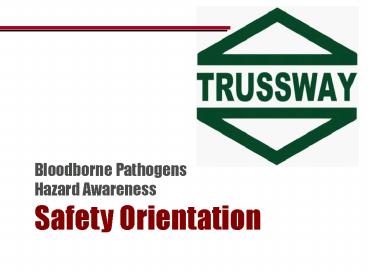Bloodborne Pathogens Safety Orientation - PowerPoint PPT Presentation
1 / 12
Title:
Bloodborne Pathogens Safety Orientation
Description:
Bloodborne Pathogens Hazard Awareness Safety Orientation You need to know: What is a bloodborne pathogen (BBP) What diseases can be caused by a BBP exposure How PPE ... – PowerPoint PPT presentation
Number of Views:622
Avg rating:3.0/5.0
Title: Bloodborne Pathogens Safety Orientation
1
Bloodborne Pathogens Hazard Awareness Safety
Orientation
2
WHY you are taking this training
- You need to know
- What is a bloodborne pathogen (BBP)
- What diseases can be caused by a BBP exposure
- How PPE in the first aid kit can protect you from
exposure - What are your responsibilities when helping an
injured person - How self-administered first aid protects others
- Who to ask if you need or have questions about
BBP
3
Any time that you have contact with
another
persons blood, bodily fluids
or
detached tissue, you have potential
contact with
Bloodborne Pathogens
- Sometimes, situations at work may present direct
contact with blood disease-producing pathogens.
For example, another employee may be injured. - Exposure to bloodborne diseases such as Hepatitis
B (HBV), Hepatitis C (HCV) HIV
(Human Immunodeficiency Virus, which causes AIDS)
places you at risk.
4
Any time that you have contact with
another
persons blood, bodily fluids
or
detached tissue, you have potential
contact with
Bloodborne Pathogens
Safety awareness, use of barrier
protection avoiding contact
are essential in preventing infection from these
serious, potentially fatal
diseases.
5
Basics about BBP How exposures happen
- Bloodborne pathogen awareness training is
important for every employee who may face an
exposure either at work, home or another
location. - Exposure can occur during contact with another
persons blood, broken or damaged skin infected
bodily fluids. - Exposure also can occur by touching a
contaminated object for example, blood
on tools or machinery following an injury. - The most direct routes of contamination are entry
through your mouth, eyes, nose or
other mucous membranes.
6
Universal Precautions First step in protecting
against BBPs
- HIV, HBV HCV infect people of all ages,
socioeconomic classes, races backgrounds - This means you cannot identify every person
who may be carrying a
bloodborne infection. - Universal Precautions means treating any
other persons
blood, bodily fluids or detached
tissue as if it IS infected as a
way to resolve this uncertainty. - Remember that someone could be carrying a
bloodborne pathogen in their blood not know it.
7
KEEP A BARRIER between you bloodborne pathogens
- Personal Protective Equipment (PPE) protects you
from contact with potentially infectious
materials. - Routine PPE in first aid kits at first aid
stations includes medical-type gloves you can
wear while helping an injured person.
8
KEEP A BARRIER between you bloodborne pathogens
- If you have safety glasses or goggles, keep them
on as a protection against
splashes of blood or tissue into your eyes. - Contaminated PPE must be disposed of properly so
that it does not present a hazard to others.
9
CARE FOR YOURSELF Self-administered first aid
protects everyone
- If you suffer a minor cut or scrape, you go to
the first aid station get a bandage,
right? - This is an example of self-administered
first aid. - When you do this, the only person who
has contact with
your blood is YOU! - When anyone gives them self first aid for minor
injuries, this eliminates potential
contamination for everyone else. - Make sure your supervisor knows about the injury.
10
BLOOD CLEAN-UP Done ONLY by trained personnel
- In the event that an area, tools, machinery or
other items are contaminated with
human blood, only trained personnel who
have been authorized by the company may perform
clean-up decontamination. - Report immediately any blood
observed in a work
area. - This includes used bandages
or first
aid supplies. - Do not touch anything that appears to be
contaminated with blood.
11
YOUR RESPONSIBILITY
Give the help that youre willing trained
to provide
- When confronted by an injury or medical
emergency - The action that you take may save someones life.
- Alert a supervisor, or in an emergency situation
call 9-1-1 directly to avoid
delay. - If youre trained in first aid or CPR
(cardiopulmonary resuscitation),
you have the option of providing direct
assistance until help arrives. - Remember that this is YOUR decision to act as a
Good Samaritan. - You are NOT required to give first aid or CPR to
another person as part of your
employment. - If you choose to assist, use the proper PPE
available medical gloves one-way CPR
mask.
12
(No Transcript)































